If you're looking for a great houseplant to give your decor a tropical flair,
Strelitzia,
commonly known as bird of paradise,
won't disappoint
. While it's often incorrectly referred to as a banana plant (it is a cousin), you won't find any bananas growing, but if you're lucky (or rather, if your plant is truly happy) after three to five years you may just find some gorgeous blooms.
The two most common species in the
Strelitzia family, both of which can be purchased as a houseplant, look very similar, and it's a good idea to know which kind you're buying, as the end result will not be the same.
Strelitzia reginae grows to a maximum height of 5 to 6 feet and blooms with the traditional orange bird of paradise flowers; it also has a dwarf version, on which the leaves are quite small comparatively.
Strelizia nicolai can become a giant tree and blooms with dramatic cream and black bird of paradise flowers; it's less likely to be sold as a houseplant, though certainly some confusion is always a possibility. So choose wisely. It's always a good idea to be an educated houseplant buyer, especially when it comes to investing in something that you hope to enjoy for years to come.
Below you'll find examples in which bird of paradise has been used in a variety of settings, and I've added some tips that I hope will be helpful as you navigate the road to using houseplants to enhance your home.
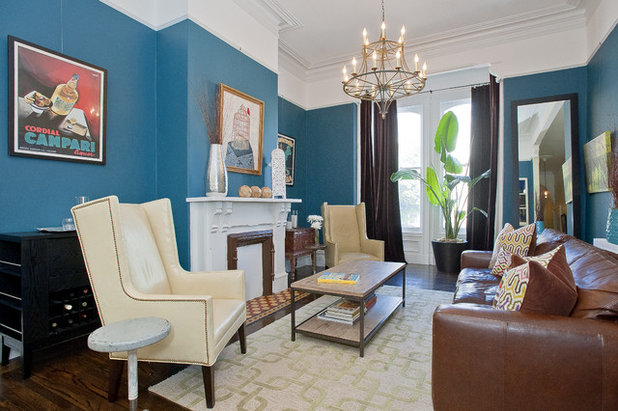
Melissa Lenox Design
The large green bird of paradise leaves are a great complement to the peacock blue walls in this eclectic San Francisco living room. I'd like to see some more green plants to balance the sea of intense color, especially behind the cream chair in the foreground, but this is a great start.

Bosworth Hoedemaker
The plant is a fabulous addition to this neutral Seattle living room. Its tropical flavor is a perfect match for the bamboo blinds, sisal area rug and neutral beachy decor, which allude to the ocean view beyond. One plant looks great, though a second one on the right side of the window would perfectly frame the view and really bring the outdoors in.
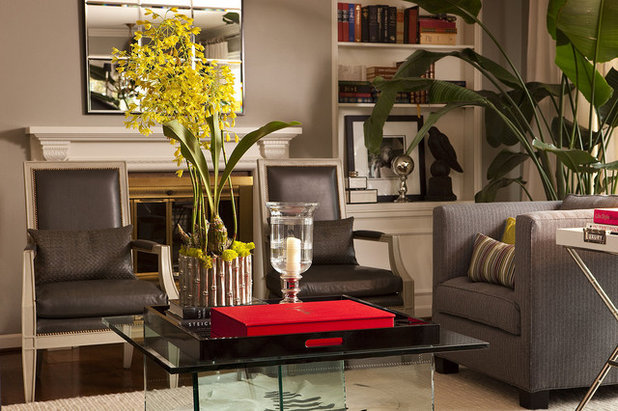
This full bird of paradise plant nicely balances the blooming orchid on the coffee table in this Portland, Oregon, home and serves to offset the formal symmetry that can sometimes make a room look more like a hotel lobby than a home.
Plants are a great way to add life to a space, since not only are they living and breathing, but they're also not perfect! A little imperfection in the form of a plant that has its own mind can be a great way to make a home feel comfortable and lived in, especially if you'd rather not have a messy look. On the other hand, a messy plant balances a little family-made mess too.
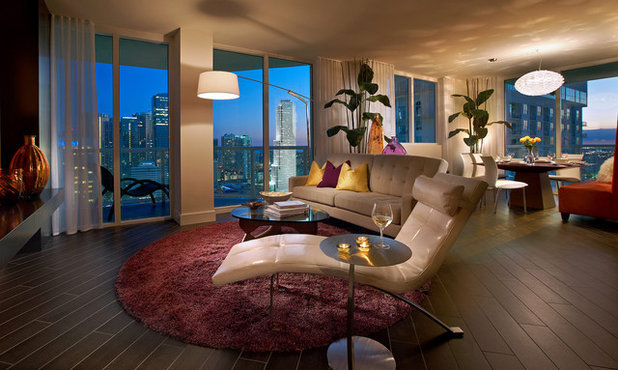
Grossman Photography
Bird of paradise is a great choice for this contemporary high-rise living space in Miami, because it connects the residents to the tropical surroundings far below and detracts from the sterility of the cityscape. The pair of plants provides grounding symmetry in this open space, as well as adds vertical interest, which is always an important element in any room.
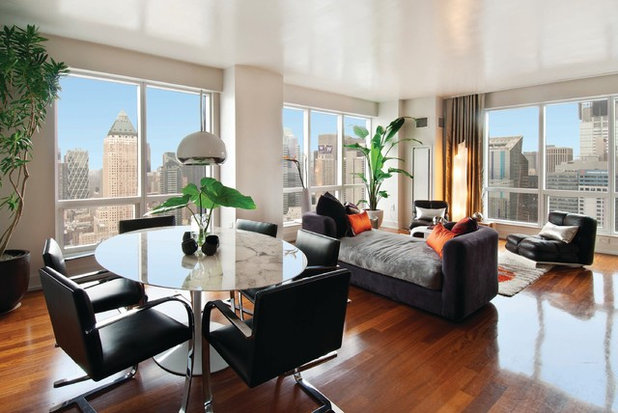
moment design + productions, llc
In this Manhattan pied-à-terre, bird of paradise does a great job of giving a human touch to the fascinating though impersonal cityscape view. Some true green is a welcome touch of color in a sea of black upholstery, and in fact, I'd love to see even more green in that far corner by way of a chunkier pot and possibly two birds of paradise planted together — there's quite a bit of blank wall space that could benefit from some large tropical leaves.
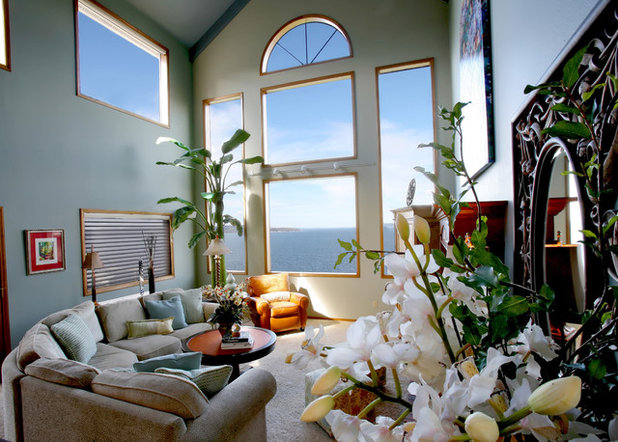
An Inside View Interior Design Studio
Here's a perfect example of a room that would benefit greatly from a
Strelitzia nicolai, as the ceiling height in this Seattle home warrants a very tall plant. The plant used is well placed, though, serving as a visual anchoring point at the end of the curved couch, and our eye has a moment of rest before taking in the vast ocean view beyond.
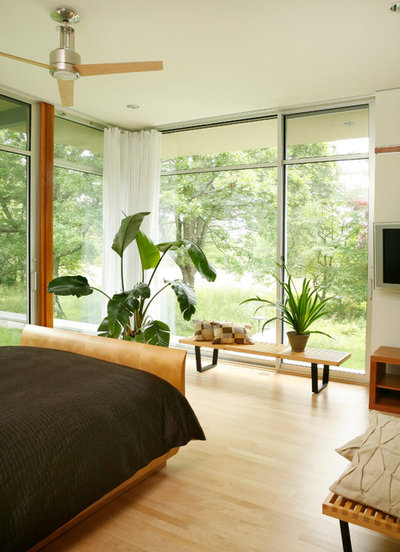
Lasley Brahaney Architecture + Construction
Bird of paradise works well in this modern Philidelphia home and fills this corner nicely, bringing the outdoors in. In this scenario, however, the plant really could be taller to fill the vertical space and to bring the eye up instead of down. Here I find myself looking at the legs of the bench instead of at the garden beyond, and wondering whether the ceiling is actually low or whether it just looks that way. Isn't it interesting how one item whose proportions aren't quite right can change everything?
Not to worry; there are a few ways to solve the problem of a plant that's lacking height while you're waiting and hoping for it to grow: a plant stand, a small low table, a stool of some kind or maybe even a few cinder blocks if your decor (and your spouse?) can handle them. Just don't forget to fertilize so you can send those cinder blocks on their way sooner rather than later.
Choosing the right plant for your home isn't always so simple, as there are many choices, and one must always consider the needs of the plant first. Add
Strelitzia to your list of possibilities, and even if it never flowers indoors, you'll still enjoy its beautiful green leaves and the touch of paradise it brings to your home.
How to care for bird of paradise:- Light: Bright light with some gentle indirect sun; too much sun can burn the leaves of plants that are designated houseplants.
- Temperature: Bird of paradise is generally not a cold-tolerant plant, and above 60 degrees Fahrenheit is preferable in the winter.
- Water: Keep the soil continuously moist year around, though bird of paradise is also known to be drought resistant, so don't worry too much if the soil gets dry between waterings; just don't overdo it. If your house temperatures drop in the winter, water less frequently.
- Soil: Plant in rich, well-drained potting mix, in a wide, as opposed to deep, pot — bird of paradise has a shallow root system and likes to spread.
- Feeding: Fertilize every two weeks in spring and summer with a balanced fertilizer to encourage blooms.
- General care: Dust the leaves regularly. High humidity is preferred, though not mandatory. Mist the plant with water or place it on a bed of rocks sitting in water. The water in the tray will evaporate, providing humidity for the plant. Additionally, bird of paradise likes to be pot bound; it will bloom better this way. So if you divide the plant or move it into a larger pot, it may take several more years to bloom.
- Air purification: While it's not known as a superhero in reducing airborne toxins, all broad-leaved plants are effective in improving indoor air quality.
- Poison index: Though it's not considered poisonous, toxins are found in both the leaves and seeds that can adversly affect humans, cats, dogs and rabbits if consumed. Children and small animals are at greater risk, and leaf consumption is more worrisome than seed consumption.
- Native habitat: South Africa





